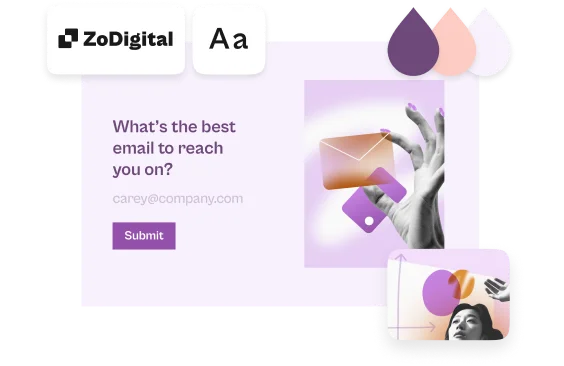Create forms in multiple languages (workaround)
In this multicultural world without frontiers, it is only natural that sometimes you want to share your form with people in different languages.
On a Business plan or higher, you can create multi-language forms, but there are also workarounds for using multiple languages in the same form.
Show all the questions in two languages
You can simply type in the questions in the two languages. For example: Question 1: What’s your name? / ¿Cómo te llamas?
This will allow you to put out there the question in both languages, as some printed government forms do, and make full use of your question limit if you're on a Free plan.
When doing this, it is also advisable to change the system messages to show the text in two languages too.
Use Logic to direct respondents to different question sets
You can take advantage of Logic to create your multilingual form. To do this, add all the questions in the chosen languages. Then, on the first question ask the respondents for their preferred language and direct them to the set of questions in that language.
This is ideal for forms in only two languages and you must remember that system messages will need to be adapted to both (OK buttons, failure messages, etc.).
Take a look at this example:
A clever twist: use multiple forms
If you’d like your respondents to see the whole form in their language (system messages included), you’d need to create all forms in each language.
This is most useful with embedded forms, as you won’t need to embed them all, but instead have only one that redirects people to the correct form.
Results will be collected separately per form. However, check out this article on how to channel the results of several different forms into a single Google Sheet.
Option A: Use Logic and different Ending Screens
Have one form ask for their preferred language, and direct people to different Endings with Logic. Each one will link to the form of their chosen language.
Option B: Use Redirect to URL and Recall information
Depending on your plan's features, you can also create a seamless multi-language experience using Redirect to URL and Recall information.
Take a look at the form below and select your preferred language:
You probably noticed that you were redirected to a different form after choosing a language. Can you guess what the magic trick was here?
Marta, our support team wizard, engineered this experience for newbies at Typeform. Now, we’re revealing her secret:
1. Create a different form for each of your languages. Create the same questions for each form, but in a different language each time.
2. Now create another form. This is the form respondents will use to select a language - then, they'll be redirected to a second form in the language of their choice. Add a Welcome Screen to this new form.
3. Then add a Picture Choice question to this form asking about language preference. Make it required.
You can add a picture for each of your languages, and leave the Picture Choice label fields as they are for now. Try adding flags or other types of images that’ll help your users identify languages.
Note how the language labels in the example below are part of the images and not typed into the label fields:
4. Take a look at the URLs of each of your forms created in different languages. At the end of each URL, you'll see a unique set of characters. This is your form's unique identifier, or UID.
To find the UID for each form URL, go to the Share panel:
5. Copy the UID of each of your forms in different languages. Go to your language choice form and add the UIDs as the Picture Choice labels for their respective languages.
6. Go to your Question settings and toggle the switch to turn off Show labels.
This will make the choice label field invisible, but the text you just added can still be recalled from these fields. Check out this article to find out more about Picture Choice labels.
Now, you can start using the Picture Choice label fields in the language selection form to pipe information into other forms. Your users won’t even notice how you’re using these secret fields to do magic tricks!
7. Click the + sign next to Endings and choose Redirect to URL. You'll need a Typeform Plus plan or above to see this option:
8. Copy and paste your generic form URL without the UID into the text field under Settings, in the right-hand sidebar:
Redirects only let you type one URL in the text field, but you can pipe information into it from previous questions to redirect users to different URLs based on their responses.
In this case, the generic form URL and the UIDs of the various language forms that we added to our Picture Choice question will add up to different redirect URLs.
9. Click @ to open the Recall information from… popup, and select the Picture Choice question.
This is what the URL used to redirect people to their selected language will look like with Recall information:
Et voilà! When a respondent makes a selection in the Picture Choice question, the redirect URL will be autofilled with the UID that belongs to the right form. Your users will now be sent to fill out the form in their chosen language.



